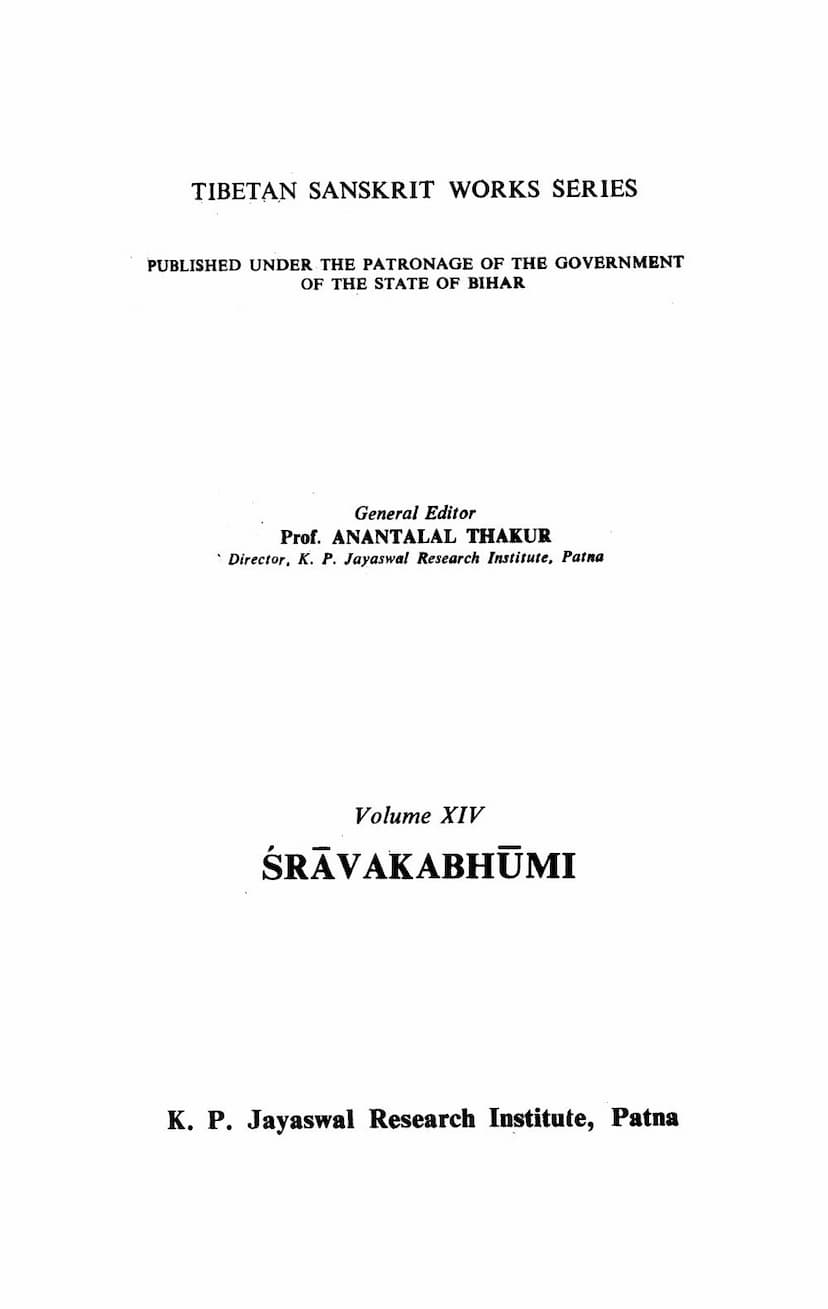Shravak Bhoomi
Added to library: September 2, 2025

Summary
Here's a comprehensive summary of the Jain text "Shravak Bhoomi" by Karunesha Shukla, based on the provided catalog link and page content:
Book Title: Śrāvakabhūmi Author: Ācārya Asaṅga Deciphered and Edited by: Dr. Karunesha Shukla Publisher: Kashi Prasad Jayaswal Research Institute, Patna Year of Publication: 1973 Series: Tibetan Sanskrit Works Series, Vol. XIV
Overview:
The Śrāvakabhūmi is a significant text within the Yogācārabhūmiśāstra, a foundational work attributed to the influential Buddhist philosopher Ācārya Asaṅga. This critical edition, meticulously deciphered and edited by Dr. Karunesha Shukla, makes the Sanskrit text of the Śrāvakabhūmi available for the first time to the scholarly world. The book is published under the patronage of the Government of Bihar and highlights the rich tradition of learning in ancient Bihar.
Key Aspects and Content:
-
Authorship and Context: The text is attributed to Ācārya Asaṅga, a prominent figure in the development of Yogācāra Buddhism. The Śrāvakabhūmi is considered the thirteenth section (bhūmi) of the larger Yogācārabhūmiśāstra, which is believed to contain seventeen distinct sections detailing the stages of a Bodhisattva's path from the Yogācāra perspective. The discovery and publication of this Sanskrit original are seen as a fulfillment of hopes to make the complete Yogācārabhūmiśāstra accessible.
-
Manuscript and Editorial Work: The edition is based on a photostatic copy of a single manuscript found in the Shā-lu monastery in Tibet, brought to India by Mahāpaṇḍita Rāhula Sāṁkstyāyana. The manuscript material was found to be defective, incomplete, and corrupt in several respects, including missing portions and textual intrusions. Dr. Shukla's extensive work involved deciphering the script, reconstructing missing parts with the help of Tibetan translations, and meticulously editing the text. The introduction details the critical apparatus used, paleographical notes, and the challenges faced in preparing this edition.
-
Thematic Content of Śrāvakabhūmi: The Śrāvakabhūmi delineates the practices and stages of spiritual development for a śrāvaka (a disciple who hears the Buddha's teachings) within the Yogācāra framework. It describes the gradual steps in the career of propitiation and accomplishment for a śrāvaka. The text delves into various concepts related to ethical conduct, mental cultivation, and the path to liberation, often referencing and engaging with earlier Buddhist doctrines, including those of the Mahīśāsaka and Sarvāstivāda schools, to which Asaṅga was initially related. It also explores the acquisition of the pratyekabuddha and bodhisattva stages.
-
Detailed Structure: The published text is divided into four Yogasthānas (stages or sections of practice):
- Book 1: Gotrabhūmi (The Basis of Spiritual Lineage): This section likely deals with the inherent potential or disposition (gotra) of an individual for spiritual progress, outlining the characteristics of beings progressing on different paths (śrāvaka, pratyekabuddha, bodhisattva).
- Book 2: Avatārabhoomi (The Stage of Descent/Entry): This section probably describes the stages of entering the path or the descent into the path of practice.
- Book 3: Naiṣkramyabhūmi (The Stage of Renunciation): This part focuses on the process of renunciation, detachment from worldly desires, and the path leading away from samsara.
- Book 4: The final section (title not fully discernible in the provided excerpt but implied to continue the discourse on Yogācāra practice).
-
Introduction and Scholarship: The extensive introduction by Dr. Karunesha Shukla is a crucial part of the publication. It provides valuable context by discussing:
- Preliminary Remarks: The place of the Śrāvakabhūmi within the Yogācārabhūmiśāstra.
- Authorship: The life, works, and probable dating of Ācārya Asaṅga.
- Sources: Asaṅga's extensive use of both Buddhist and Brahmanical literature, including the Upanishads and Ayurvedic texts, which influences his philosophical expositions. It also highlights his reliance on Mahāyāna Sūtras and other Buddhist works.
- Paleographical Notes: Details about the script used in the manuscript.
- Asanga's Erudition: His mastery of various Buddhist schools (Theravāda, Mahāyāna), philosophical traditions, and even secular knowledge like Ayurveda.
- Asanga and Tantras: Debunking the association of Asaṅga with Tantric literature.
- Doctrinal Aspects: Asaṅga's integration of Abhidharma, Madhyamika, and Yogācāra idealism.
- Asanga and Ayurveda: Tracing influences of Ayurvedic concepts in his works.
-
Dedication: The edition is dedicated to Shri C. Balkrishna Rao, I. C. S., Vice-Chancellor, Agra University, as a token of respect and gratitude.
Significance:
This critical edition of the Śrāvakabhūmi is essential for scholars of Buddhist philosophy, history, and literature. It provides access to a vital text that was previously largely unavailable in its original Sanskrit form, contributing significantly to understanding the development of Yogācāra thought and the comprehensive philosophical system articulated by Ācārya Asaṅga. The work is a testament to the dedication of the Kashi Prasad Jayaswal Research Institute in preserving and disseminating ancient Indian knowledge.